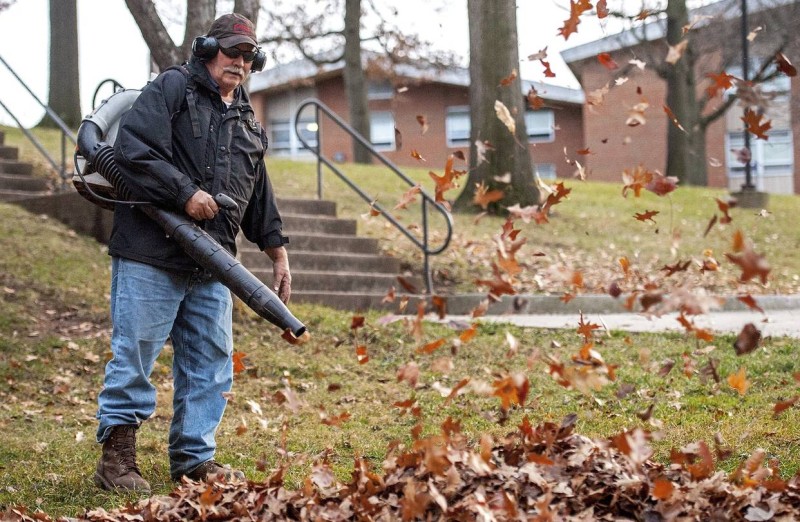Once autumn leaves are down, landscapers with leaf blowers strapped to their backs pour into America’s neighborhoods like hornets from a hive.
Which raises an interesting question: How much pollution does a leaf blower emit?
The short answer is more than a car, a truck or any other modern passenger vehicle.
But because vehicles outnumber the nation’s 12 million leaf blowers by about 224 million, they still beat out the dirtier engines in total emissions.
“These small engines are notoriously high polluters. But because there are fewer of them compared to cars and trucks, they don’t emit as much total pollution,” said John Volckens, a professor of mechanical engineering at Colorado State University.
The U.S. Environmental Protection Agency and Quiet Communities, a nonprofit that advocates for quieter and cleaner lawn maintenance, estimated that in 2011 there were nearly 11 million leaf blowers and vacuums in the country, a figure they projected would grow to around 12 million by 2018.
The EPA has regulated leaf blowers and other small nonroad spark-ignition engines since 1997. The machines are divided into two categories: handheld equipment, such as leaf blowers and chain saws; and non-handheld equipment, such as lawn mowers and generators.
Emissions standards limit how many grams of carbon monoxide, nitrogen oxides and hydrocarbons the engines can produce per hour, taking the size of the engine into account. The pollutants are measured in laboratory tests that simulate how the engines would be used in the real world.
The California Environmental Protection Agency estimated that operating a commercial leaf blower for one hour would emit more pollution than driving a 2016 Toyota Camry for about 1,100 miles.
Overall, EPA figures show that the small nonroad spark-ignition engines contribute 1% of nitrogen oxides to total U.S. emissions, compared with 16% contributed by passenger cars; 2% of volatile organic compounds, compared with 3%; 15% of carbon monoxide, compared with 29%; and 1% of particulate matter, the same amount as passenger cars. The data, which is the latest available, are from 2014.
The pollutants contribute to a variety of health problems and cause smog, acid rain and other environmental hazards.
The reason leaf blowers and related devices are so dirty is because many use two-stroke engines.
Stroke refers to the distance a piston travels in its cylinder. A two-stroke engine rotates the crankshaft once in one cycle of internal combustion, producing power every second stroke. A four-stroke engine rotates the crankshaft twice in one cycle of internal combustion, producing power with every fourth stroke.
Four-stroke engines are more efficient, but two-stroke engines are inexpensive and pack more power. They also run in any position—even sideways or upside down—a feature made possible by the way they are lubricated.
Four-stroke engines must operate in a generally upright position because their lubricating system would spill oil, if the engine were turned upside down
Two-stroke engines lack a separate lubrication system; their oil is mixed in with the gasoline used for fuel. Some of it lubricates the engine, and some of it burns up, but a significant amount escapes through the exhaust.
All gasoline engines expel some unburned fuel in their exhaust, but two-stroke engines release a higher percentage. Still, improvements in recent years have reduced emissions, according to George Klein, an outdoor power equipment instructor at Walla Walla Community College in Washington state.
New ignition systems help two-stroke engines crank more easily, idle at slower speeds and accelerate more quickly, contributing to reductions in exhaust, Mr. Klein said. Synthetic oils burn better and allow the engines to operate with less oil in the fuel mixture. And new styles of engines use buffers of air to reduce fuel losses. Today two-stroke engines are up to 85% cleaner than before the emissions were regulated.
Nonetheless, communities such as Palm Springs, Calif. and Maplewood, N.J., have banned gas-powered leaf blowers because of concerns over noise and pollution that is emitted in front yards, according to Jamie Banks, the executive director of Quiet Communities.
She and her organization have counted at least 107 communities with different levels of restrictions.
The National Association of Landscape Professionals opposes efforts to ban the machines, and in some cases, the industry is fighting back.
The New Jersey Landscape Contractors Association and nine individual landscape companies filed a civil suit in October claiming Maplewood’s ban discriminates against the businesses because residents and some other groups can still use the gasoline-powered leaf blowers.
Why should they turn over a new leaf, they argue, when others don’t have to.
By Jo Craven McGinty
https://www.wsj.com/articles/that-ear-splitting-leaf-blower-it-also-emits-more-pollution-than-a-car-1513346400




